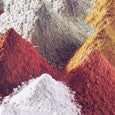The fibrous form of wollastonite can be very beneficial in bodies. In low fired ceramics wollastonite reduces drying and firing shrinkage and drying and firing warpage. It also promotes lower moisture and thermal expansion in the fired product. It fires with no LOI and its fibers help vent out gassing. These factors have made it a valuable component in tile bodies, especially for fast fire. Vitreous and semi vitreous bodies can also show reduced shrinkage with small additions (2-5%), however wollastonite becomes a stronger flux as temperatures go above 1100C.
Wollastonite exhibits a slight solubility in water, but slips containing it can become more alkaline (potentially affecting rheological properties).
At higher temperatures the powder form is valuable as a source of CaO flux in glazes (and bodies). The other main raw source of CaO is whiting but it releases a high volume of gases of decomposition which produce suspended micro-bubbles that demand slow firing to clear. Also, since wollastonite sources silica as well, glaze recipes employing it do not need as much raw silica powder. Further the SiO2 and CaO react more readily to form silicates. Thus wollastonite is used as a major flux in high temperature sanitaryware and electrical insulators.
Wollastonite has the ability to seed crystals (in glaze melts of sympathetic chemistry), and can be valuable to create special effects which depend on devitrification (crystallization during cooling). Since CaO tends to devitrify in high temperature slow cooled glazes wollastonite can be employed to make faster cooled lower CaO content ones exhibit the same effect.
Wollastonite exhibits a slight solubility in water, but slips containing it can become more alkaline (potentially affecting rheological properties).
At higher temperatures the powder form is valuable as a source of CaO flux in glazes (and bodies). The other main raw source of CaO is whiting but it releases a high volume of gases of decomposition which produce suspended micro-bubbles that demand slow firing to clear. Also, since wollastonite sources silica as well, glaze recipes employing it do not need as much raw silica powder. Further the SiO2 and CaO react more readily to form silicates. Thus wollastonite is used as a major flux in high temperature sanitaryware and electrical insulators.
Wollastonite has the ability to seed crystals (in glaze melts of sympathetic chemistry), and can be valuable to create special effects which depend on devitrification (crystallization during cooling). Since CaO tends to devitrify in high temperature slow cooled glazes wollastonite can be employed to make faster cooled lower CaO content ones exhibit the same effect.
The fibrous form of wollastonite can be very beneficial in bodies. In low fired ceramics wollastonite reduces drying and firing shrinkage and drying and firing warpage. It also promotes lower moisture and thermal expansion in the fired product. It fires with no LOI and its fibers help vent out gassing. These factors have made it a valuable component in tile bodies, especially for fast fire. Vitreous and semi vitreous bodies can also show reduced shrinkage with small additions (2-5%), however wollastonite becomes a stronger flux as temperatures go above 1100C.
Wollastonite exhibits a slight solubility in water, but slips containing it can become more alkaline (potentially affecting rheological properties).
At higher temperatures the powder form is valuable as a source of CaO flux in glazes (and bodies). The other main raw source of CaO is whiting but it releases a high volume of gases of decomposition which produce suspended micro-bubbles that demand slow firing to clear. Also, since wollastonite sources silica as well, glaze recipes employing it do not need as much raw silica powder. Further the SiO2 and CaO react more readily to form silicates. Thus wollastonite is used as a major flux in high temperature sanitaryware and electrical insulators.
Wollastonite has the ability to seed crystals (in glaze melts of sympathetic chemistry), and can be valuable to create special effects which depend on devitrification (crystallization during cooling). Since CaO tends to devitrify in high temperature slow cooled glazes wollastonite can be employed to make faster cooled lower CaO content ones exhibit the same effect.
Wollastonite exhibits a slight solubility in water, but slips containing it can become more alkaline (potentially affecting rheological properties).
At higher temperatures the powder form is valuable as a source of CaO flux in glazes (and bodies). The other main raw source of CaO is whiting but it releases a high volume of gases of decomposition which produce suspended micro-bubbles that demand slow firing to clear. Also, since wollastonite sources silica as well, glaze recipes employing it do not need as much raw silica powder. Further the SiO2 and CaO react more readily to form silicates. Thus wollastonite is used as a major flux in high temperature sanitaryware and electrical insulators.
Wollastonite has the ability to seed crystals (in glaze melts of sympathetic chemistry), and can be valuable to create special effects which depend on devitrification (crystallization during cooling). Since CaO tends to devitrify in high temperature slow cooled glazes wollastonite can be employed to make faster cooled lower CaO content ones exhibit the same effect.

